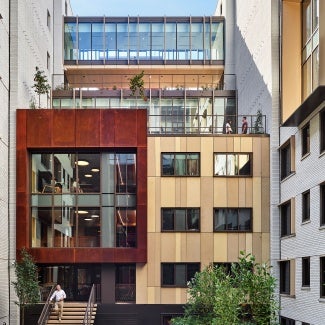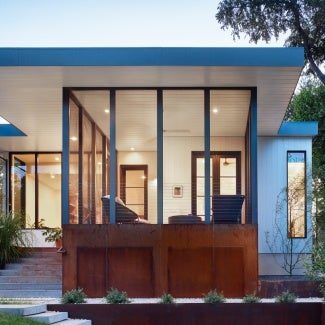Woodward Lofts
The award-winning housing design of Woodward Lofts in St. Louis creates 164 loft-style apartments that both honor the former factory building’s industrial legacy and help meet the community’s housing unit shortfall.

Project highlights: Woodward Lofts
- Architect: Trivers
- Owner: Michael Hamburg | Pier Property Group
- Location: St. Louis
- Category: Multifamily housing
- Project site: Previously developed
- Building program type(s): Residential - multi-family, 5 or more units
In 2016, when St. Louis faced a 20,000 housing unit shortfall, this project’s developer turned to the Woodward & Tiernan Printing Company, a massive factory that landed on the National Register of Historic Places for its pioneering application of the daylight factory style. Today, the building contains 164 loft-style apartments that both honor its industrial legacy and meet the developer’s financial model.
When the factory originally opened in 1925 at Tower Grove and Vandeventer avenues, its innovative design included five clerestory monitors and mushroom-capital concrete floors. The building was still considered modern as late as 1959, when Woodward & Tiernan was absorbed for expansion. In the 1980s, however, the building’s presence in the neighborhood shifted drastically, and while the concrete structure withstood the march of time, its brick facades and terra cotta ornamentation fell into disrepair. It became a hulking and uninviting presence at the edge of a struggling neighborhood.
Maximizing its residents’ connections to the building's history was the primary goal of the factory’s redevelopment. The team excised the low roofs between the clerestory monitors to boost daylight in the living spaces and shifted the floor area to new lofted bedrooms to increase the building’s usable square footage. A series of gardens engage the senses, creating intimate outdoor rooms where vestiges of the original structure serve as an implied ceiling.
Echoes of the overarching design concept are embedded in numerous project details. The new garden facades evoke letterbox trays used in old printing processes, murals of which adorn the walls at key entrance points. Ink-like tones for carpet and paint selections and reprints of original Woodward & Tiernan products create an additional series of wall murals. Above, the original sprinkler penthouse now functions as a rooftop lounge where two tanks serve as banquette seating areas.
Adaptive reuse of the original structure is highlighted by steel purlins and trusses, timber decking, mushroom-capital columns, and board-formed concrete. Several elements of the open floor plates persist, including original oak office partitions that now shape co-working spaces and original terrazzo floors (a surprising discovery) that now shine after hiding beneath decades of dirt.
The factory’s reuse resulted in a 60% reduction in new construction costs at the time, a financial success for the client. With its historic foundation, Woodward Lofts is a substantial and compelling bookend to the Forest Park Southeast neighborhood at one of its busiest intersections.
Framework for Design Excellence measures
Was there a design charrette? Yes
Site area that supported vegetation (landscape or green roof) pre-development: 1%
Site area that supports vegetation post-development: 40%
Site area covered by native plants supporting native or migratory species and pollinators: 20%
Strategies used to promote Design for Ecosystems: Dark skies, Abatement of specific regional environmental concerns
Is potable water used for irrigation? Yes
Is potable water used for cooling? No
Is grey/blackwater reused on-site? No
Is rainwater collected on-site? No
Stormwater managed on-site: 0
2030 Commitment baseline EUI: 35 kBtu/sf/yr
Predicted net EUI including on-site renewables: 61 kBtu/sf/yr
Is the project all-electric? Yes
Level of air filters installed: MERV 12-14
Was a “chemicals of concern” list used to inform material selection? No
Do greater than 90% of occupied spaces have a direct view to the outdoors? No
Were embodied carbon emissions estimated for this project? No
Estimated service life: 50 years
Floor area, if any, representing adapting existing buildings: 100%
Ability to survive without utility power: Passive survivability
Which of the following risk assessment and resilience services were provided? None of the above
Has a post-occupancy evaluation been conducted? Yes
Building performance transparency steps taken:
Present the design, outcomes, and/or lessons learned to the office,
Present the design, outcomes, and/or lessons learned to the profession
Framework for Design Excellence measures
Year of substantial project completion: 2019
Gross conditioned floor area: 179268 sq. ft.
Engineer - Civil: CDI
Engineer - Structural: KPFF
Consulting Engineers Engineer: MEP
Design-Assist: G&W Engineering
Consultant - Acoustics: Designed Acoustics
Catherine Baker, FAIA, Chair, Nowhere Collaborative, Chicago
John DeForest, AIA, DeForest Architects, Seattle
Brian Lane, FAIA, Koning Eizenberg, Santa Monica, Calif.
Amit Price Patel, AIA, DIALOG, Vancouver, British Columbia
Michael D. Robinson, AIA, Robi4 Architecture & Planning, San Diego
The Housing Award emphasizes good housing as a necessity of life, a sanctuary for the human spirit, and a valuable national resource. Recipients show the world how beauty, safety, sustainability, and comfort can come together.
Ten projects showcase the best in housing design.













